April 20, 2022
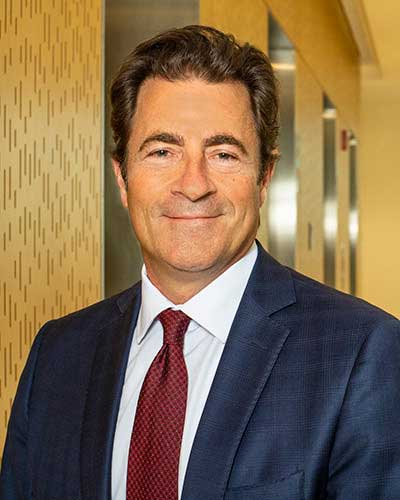
Acclaimed physician-scientist, clinician, and academic leader set to begin August 1
University of Maryland, Baltimore (UMB) President Bruce E. Jarrell, MD, FACS, has appointed leading heart, vascular, and lung physician-scientist Mark T. Gladwin, MD, as the new dean of the University of Maryland School of Medicine (UMSOM) and Vice President for Medical Affairs.
The selection was made following a rigorous national search and is effective August 1, 2022. Dr. Gladwin is the Jack D. Myers Distinguished Professor and Chair of the Department of Medicine at the University of Pittsburgh School of Medicine (UPSOM) and founder of the Pittsburgh Heart, Lung, Blood, and Vascular Medicine Institute.
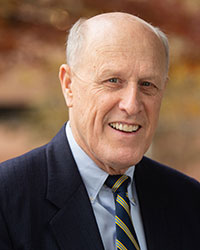 “I could not be more pleased to announce Dr. Gladwin as the next dean of the University of Maryland School of Medicine,” Jarrell said. “I am confident he will continue to enrich the legacy of our School of Medicine and position our world-class institution to meet the challenges of the future.”
“I could not be more pleased to announce Dr. Gladwin as the next dean of the University of Maryland School of Medicine,” Jarrell said. “I am confident he will continue to enrich the legacy of our School of Medicine and position our world-class institution to meet the challenges of the future.”
“I am very honored to have been selected as dean of one of the most prestigious medical schools in the country,” said Dr. Gladwin, who also serves as associate dean for physician-scientist mentoring at UPSOM, and associate vice chancellor for science strategy, health sciences, at the University of Pittsburgh School of Medicine.
“Everything I learned during my visit to UMB furthered my desire to join the University of Maryland School of Medicine,” he continued. “I was already well aware of its reputation for excellence in education, research, clinical care, and community outreach. I look forward to listening to, and learning from UMB faculty, staff, and students as we continue the crucial work of carrying the School’s mission forward in Baltimore, around the state, and around the world.”
Extensive National Search
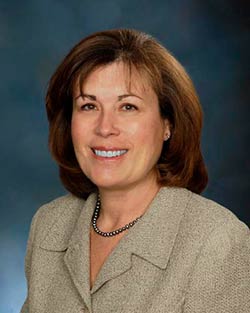 Dr. Gladwin’s appointment follows a comprehensive search process led by a committee that included faculty, staff, and administrators, as well as student representatives. The committee sought the best candidates to lead the school in its academic and clinical missions, to work closely with the University of Maryland Medical System (UMMS), and represent UMSOM effectively with its many stakeholders, especially those in the Baltimore community.
Dr. Gladwin’s appointment follows a comprehensive search process led by a committee that included faculty, staff, and administrators, as well as student representatives. The committee sought the best candidates to lead the school in its academic and clinical missions, to work closely with the University of Maryland Medical System (UMMS), and represent UMSOM effectively with its many stakeholders, especially those in the Baltimore community.
“Dr. Gladwin is an exceptional choice to lead the School of Medicine,” said Claire M. Fraser, PhD, Dean’s Endowed Professor of Medicine, director of the Institute for Genome Sciences, and chair of the search committee. “I'm extremely excited and looking forward to Dr. Gladwin’s arrival,” Fraser continued. “The search committee was impressed by not only his experience, but also his vision for the future of medicine and the role of the medical school in today's society.”
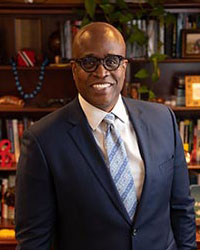
“Being the leader of the School of Medicine is a challenging, multifaceted job,” added search committee co-chair Roger J. Ward, JD, EdD, MSL, MPA, provost and executive vice president, and dean of the University of Maryland Graduate School. “With his wide range of experience, it was evident to the committee that Dr. Gladwin will excel in every aspect of what this job entails.”
 One of the two student members of the selection committee, Aishwarya Iyer, an MD/PhD student in the School of Medicine and president of the University Student Government Association, agreed. “I thought his research portfolio was phenomenal,” she said. “He comes from a really strong institution and has a lot of experience managing his position very well and very efficiently. I am excited to welcome this new dean.”
One of the two student members of the selection committee, Aishwarya Iyer, an MD/PhD student in the School of Medicine and president of the University Student Government Association, agreed. “I thought his research portfolio was phenomenal,” she said. “He comes from a really strong institution and has a lot of experience managing his position very well and very efficiently. I am excited to welcome this new dean.”
Key Focus on Equity, Diversity, and Inclusion
As dean, Dr. Gladwin will be responsible for sustaining a culture that embodies UMB’s core values and promoting and enhancing diversity, equity, and inclusion at UMSOM while leading advances and innovation in the areas of education, research, and clinical care.
Throughout his career Dr. Gladwin has been committed to promoting diversity, equity, and inclusion, informed by a life-long commitment to the care and development of new treatments for patients with sickle cell disease. As department chair, he created a new vice chair position for diversity and inclusion with significant financial resources to create and administer new and innovative programs.
Working with the vice chair and residency director he developed specialty tracks that aimed to attract accomplished underrepresented minority faculty into the research residency, linked to scholarship programs with novel micro-credential MBA and MPH training opportunities, financially supplemented with T32 and philanthropic support, Burroughs Wellcome Foundation physician-scientist incubator support, and departmental investments.
He established an under-represented minority advisory committee, consisting of under-represented minority faculty leaders at all levels, who work together to identify challenges and provide insight, expertise, and a forum for improvement. Under his leadership the Department of Medicine has aggressively recruited, retained, and promoted fellows and faculty that are underrepresented in medicine, and recruited a diverse leadership team at the divisional and vice chair level.
History of Accomplishment
Born in Palo Alto, Calif, and raised in the U.S. as well as Ghana, Mexico, and Guatemala, Dr. Gladwin earned his bachelor’s and medical degrees from the University of Miami’s six-year honors program in medical education. He completed his internship and chief residency in internal medicine at the Oregon Health Sciences University, followed by a critical care medicine fellowship at the National Institutes of Health (NIH) in Bethesda, and a pulmonary fellowship at the University of Washington in Seattle.
Dr. Gladwin’s career has included serving in the roles of physician-scientist, clinician, educator, and academic leader at two institutions, the University of Pittsburgh and the NIH. At both institutions, he was consistently promoted to greater responsibility and leadership, building new programs and improving existing ones. At NIH, he served as critical care fellow, senior research fellow section head for the Sickle Cell Nitric Oxide Therapeutic and Vascular Therapeutics sections, director of the functional genomics core, and Chief of the Pulmonary and Vascular Medicine Branch of the National Heart, Lung, and Blood Institute.
In 2008, Dr. Gladwin was recruited to the University of Pittsburgh to serve as Chief of the Division of Pulmonary, Allergy and Critical Care Medicine (PACCM) and the inaugural Director of the Vascular Medicine Institute. He assumed the role of Department Chair in 2014, overseeing more than 800 faculty (including 120 PhD faculty and an additional >170 advanced practice providers) and combined clinical and research revenues approaching $300 million dollars. During his tenure the Departments NIH funding increased by more than 25%, and has been ranked in the top ten funded Departments of Medicine in NIH funding for the last 4 years, according to the Blue Ridge Institute for Medical Research.
At the University of Pittsburgh Medical Center, Dr. Gladwin worked to establish clinical programs to increase patient access to quality care and supported the development of signature programs in clinical analytics, telemedicine, E-consultation, critical care, specialty and hospitalist services, and multidisciplinary Clinical Centers of Excellence across 10 divisions.
As the Department of Medicine chair, he also supported the development of a long list of research centers of excellence, including in aging, vascular biology, the microbiome, metabolism, mitochondrial biology, antibody therapeutics, and sickle cell research, the latter of which has been a focus of Dr. Gladwin’s own research for more than 20 years. Dr. Gladwin credits his leadership success to careful listening and fact finding, the recruitment and partnership with strong leaders, the use of analytics to measure performance and provide feedback, and the thoughtful alignment of incentives to galvanize stakeholder support and sustainability.
Research Impact
 From a research standpoint, Dr. Gladwin has published more than 470 manuscripts since 1996, which have had a significant impact on the fields of vascular and nitric oxide biology. His work is cited more than 5,000 times per year with an h-index of >120 (data from Google Scholar). Among his major scientific discoveries is the finding that the nitrite salt is a biological signaling molecule that regulates physiological and pathological hypoxic responses, blood pressure and flow, and dynamic mitochondrial electron transport.
From a research standpoint, Dr. Gladwin has published more than 470 manuscripts since 1996, which have had a significant impact on the fields of vascular and nitric oxide biology. His work is cited more than 5,000 times per year with an h-index of >120 (data from Google Scholar). Among his major scientific discoveries is the finding that the nitrite salt is a biological signaling molecule that regulates physiological and pathological hypoxic responses, blood pressure and flow, and dynamic mitochondrial electron transport.
He characterized the role of hemoglobin and myoglobin as signaling nitrite reductases that regulate NO production under hypoxia. His seminal publication on this topic in 2003 has been cited more than 1800 times and is listed by Nature Medicine in its top ten Classic Collection. This work has led to the development and licensing of intravenous, oral, and inhaled nitrite as a human therapeutic.
In addition to studies of nitrite, he characterized a novel mechanism of disease, hemolysis-associated endothelial dysfunction. This work has described a state of resistance to nitric oxide in patients with sickle cell disease, malaria, transfusion of aged blood, and other hemolytic conditions, caused by scavenging of nitric oxide by hemoglobin that is released into plasma during hemolysis. These studies translated to clinical and epidemiological descriptions of a human disease syndrome, hemolysis-associated pulmonary hypertension.
Most recently, his laboratory has pioneered the use of recombinant neuroglobin and heme-based molecules as antidotes for CO poisoning, and this work resulted in the formation of a company, Globin Solutions. From a clinical research standpoint Dr. Gladwin has a long history of leadership of translational projects and programs, having served as a principal or associate investigator on more than 50 human subjects protocols and holding at least 10 FDA INDs for the use of investigational therapeutic medications. He has served as PI on major multicenter phase II clinical trials, including the DeNOVO trial of NO therapy for acute pain crisis in patients with sickle cell disease, the Walk-PHASST trial of sildenafil for pulmonary hypertension secondary to sickle cell disease, and the current STERIO-SCD and SCD-CARRE trials evaluating new treatment approaches for patients with sickle cell disease.
Dr. Gladwin is a member of the American Osteopathic Association, the American Society for Clinical Investigation (ASCI), the Association of Professors of Medicine (APM), and the Association of American Physicians, and has served on the ASCI and APM councils. He is a Fellow of the American College of Physicians, American Heart Association, Association of American Physicians (AAP), and Pulmonary Vascular Research Institute. He has received numerous academic awards including the US Public Health Service Achievement Award, the NIH Director’s Award for Mentoring, the NIH Clinical Center Director’s Award for Science, the NIH Merit Award in recognition for accomplishments in both basic and clinical sciences, the Recognition Award for Scientific Accomplishments from the American Thoracic Society, was named an American Heart Association Distinguished Scientist, and was recognized as Distinguished Professor at the University of Pittsburgh 2014.
A Passion for Education
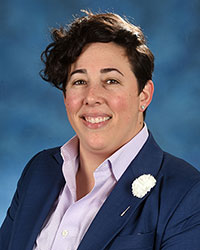 A central passion of Dr. Gladwin’s is to train the next generation of physicians and scientists in translational research. He has trained students at all levels and has been very successful at mentoring these trainees to independent careers in academic medicine. His publications include more than 150 with current or past trainees as first author.
A central passion of Dr. Gladwin’s is to train the next generation of physicians and scientists in translational research. He has trained students at all levels and has been very successful at mentoring these trainees to independent careers in academic medicine. His publications include more than 150 with current or past trainees as first author.
“I’m beyond ecstatic that Dr. Gladwin will be the new dean of the University of Maryland School of Medicine,” said Andrea R. Levine, MD, assistant professor at UMSOM who served a pulmonary, allergy, and critical care fellowship at the University of Pittsburgh Medical Center with Dr. Gladwin in 2018.
“Dr. Gladwin was instrumental in recruiting me to Pittsburgh where he personally served as my research, clinical, and professional mentor. He was foundational in my becoming the doctor, physician-scientist, and the person I am today. He taught me how to be a critical care doctor. I cannot wait to see the impact he has on the growth and development of the University of Maryland School of Medicine including the students, trainees, and faculty.”
Engagement with UMB Community
The search process at UMB included a series of town halls where members of the community gathered to listen to the leading candidates present their views on various topics and to ask questions afterward.
During Gladwin’s Feb. 14 town hall presentation “A Perspective on Values and Vision for Academic Medical Centers,” he discussed his values; challenges and opportunities for progress in medical education; research, and clinical care; diversity, equity, and inclusion; and what his initial priorities would be for UMSOM.
“I am delighted to join your successful institution,” he said. “I think that the first thing that would be the absolute top priority for me on day one will be to listen and learn. I look forward to hearing all about the science, the successes, and challenges of all the research, clinical, and training programs. I understand the challenges our physicians and all health care workers face, especially after the COVID-19 pandemic, and appreciate the needs of the communities and patients that we serve. So, first and foremost, I intend to be a student, and will invest and put enormous effort into knowing the faculty, students, community, and health care needs of the state, and engaging our campus in facing our many generational challenges in medicine.”
Growing Partnership with Medical System and Medical Center
 Mohan Suntha, MD, MBA, president and chief executive officer of the University of Maryland Medical System, which works closely with UMSOM in research, education, and clinical practice, said he was eager for Dr. Gladwin to come on board.
Mohan Suntha, MD, MBA, president and chief executive officer of the University of Maryland Medical System, which works closely with UMSOM in research, education, and clinical practice, said he was eager for Dr. Gladwin to come on board.
“The University of Maryland School of Medicine is a foundational partner for the University of Maryland Medical System and collaborating with our scientist-physician colleagues makes it possible for our System to be a differential resource in providing exceptional care to the communities we serve across the state,” Dr. Suntha said. “Together, we deliver cutting-edge clinical care, educate the physicians of tomorrow and innovate the cures of the future, and under Dr. Gladwin’s leadership, I look forward to growing and deepening the ties that have been the foundation of our successful partnership."
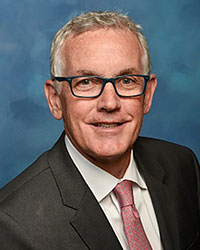 Added Bert W. O’Malley, MD, president and CEO of the University of Maryland Medical Center (UMMC), “UMMC’s partnership with UM School of Medicine is one of the bedrocks to our unique brand of compassionate, discovery-based care. We welcome Dr. Gladwin to Baltimore to help continue building on that strong tradition.”
Added Bert W. O’Malley, MD, president and CEO of the University of Maryland Medical Center (UMMC), “UMMC’s partnership with UM School of Medicine is one of the bedrocks to our unique brand of compassionate, discovery-based care. We welcome Dr. Gladwin to Baltimore to help continue building on that strong tradition.”
UMSOM: Among Top Echelon of Medical Schools
Over the past two decades, UMSOM has emerged among the top echelon of medical schools in the nation – with record-breaking growth and accomplishments. In research, total funding increased dramatically from $323 million in 2006 to reaching historic levels approaching $600 million in 2020. Clinical revenues have more than doubled since 2006 to $350 million, with UMSOM faculty physicians now providing outpatient and inpatient care to more than 1.5 million patients each year. Clinical practice locations have expanded across the state – growing from 6 to 62 locations.
UMSOM’s global footprint has expanded to research and treatment facilities in more than 30 countries around the world. UMSOM has become a hub of innovation with 576 scientific disclosures, 130 U.S. patents issued, 228 foreign patents issued, 205 technology inventions licensed, and 33 start-up companies formed.
In education, UMSOM launched an overhaul of the entire medical education curriculum, called the “Renaissance Curriculum,” which was successfully and fully launched amidst the COVID-19 pandemic. With construction of its new 430,000-square-foot Health Sciences Research Facility in 2018, UMSOM expanded its footprint of academic and research space to 15 buildings and nearly 2.5 million square feet. Overall, UMSOM’s reputation has never been stronger. The School now ranks among the top 10 public medical schools in U.S. News & World Report, and among the top 20 percent among all medical schools in the nation. More than half of its academic departments now rank in the top 20 according to the Blue Ridge Medical School Research Rankings.
During the past two years, UMSOM has gained unprecedented prominence on the world stage. The School played an integral role as a leading institution in the global COVID-19 response in research, testing, and therapeutics, conducting among the first clinical trials for the two leading COVID-19 vaccine candidates as well as trials for the pediatric vaccine, and the “mix and match” booster study. UMSOM conducted more than a million COVID-19 tests across the state of Maryland, and UMSOM researchers were awarded $32 million in grants for COVID-19-related research.
In January of this year, UMSOM gained widespread national and international attention when surgeons performed the historic first successful transplant of a genetically-modified porcine heart to human, a major breakthrough that was heralded by the medical and scientific community for its transformative role in changing the future of organ transplantation.
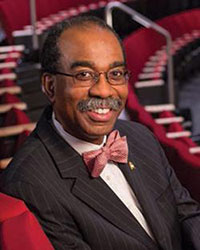 Dr. Jarrell announced in August 2021 that a national search would begin for the next UMSOM dean to succeed E. Albert Reece, MD, PhD, MBA, executive vice president for medical affairs, the John Z. and Akiko K. Bowers Distinguished Professor, who announced in March of 2021 that, after 16 years of leadership, he will transition from his role as dean and return to the UMSOM faculty as director of a new Center for Advanced Research, Training, and Innovation (CARTI) and will continue to co-direct the UMSOM Center for Birth Defects Research.
Dr. Jarrell announced in August 2021 that a national search would begin for the next UMSOM dean to succeed E. Albert Reece, MD, PhD, MBA, executive vice president for medical affairs, the John Z. and Akiko K. Bowers Distinguished Professor, who announced in March of 2021 that, after 16 years of leadership, he will transition from his role as dean and return to the UMSOM faculty as director of a new Center for Advanced Research, Training, and Innovation (CARTI) and will continue to co-direct the UMSOM Center for Birth Defects Research.
“On behalf of the School of Medicine, I’m delighted to extend heartiest congratulations and a warm welcome to Dr Gladwin on his decanal appointment,” said Dr. Reece. “I’m most pleased to ‘pass the baton’ to him and look forward to his leadership in the years to come”.
About the University of Maryland School of Medicine
Now in its third century, the University of Maryland School of Medicine was chartered in 1807 as the first public medical school in the United States. It continues today as one of the fastest growing, top-tier biomedical research enterprises in the world -- with 46 academic departments, centers, institutes, and programs, and a faculty of more than 3,000 physicians, scientists, and allied health professionals, including members of the National Academy of Medicine and the National Academy of Sciences, and a distinguished two-time winner of the Albert E. Lasker Award in Medical Research. With an operating budget of more than $1.3 billion, the School of Medicine works closely in partnership with the University of Maryland Medical Center and Medical System to provide research-intensive, academic, and clinically based care for nearly 2 million patients each year. The School of Medicine has nearly $600 million in extramural funding, with most of its academic departments highly ranked among all medical schools in the nation in research funding. As one of the seven professional schools that make up the University of Maryland, Baltimore campus, the School of Medicine has a total population of nearly 9,000 faculty and staff, including 2,500 students, trainees, residents, and fellows. The combined School of Medicine and Medical System (“University of Maryland Medicine”) has an annual budget of over $6 billion and an economic impact of nearly $20 billion on the state and local community. The School of Medicine, which ranks as the 8th highest among public medical schools in research productivity (according to the Association of American Medical Colleges profile) is an innovator in translational medicine, with 606 active patents and 52 start-up companies. In the latest U.S. News & World Report ranking of the Best Medical Schools, published in 2021, the UM School of Medicine is ranked #9 among the 92 public medical schools in the U.S., and in the top 15 percent (#27) of all 192 public and private U.S. medical schools. The School of Medicine works locally, nationally, and globally, with research and treatment facilities in 36 countries around the world. Visit medschool.umaryland.edu.
About the University of Maryland, Baltimore
Founded in 1807, the University of Maryland, Baltimore is Maryland’s only public health, law, and human services university, dedicated to excellence in education, research, clinical care, and public service. UMB enrolls more than 6,700 students in six nationally ranked professional schools — medicine, law, dentistry, pharmacy, nursing, and social work — and an interdisciplinary Graduate School. The university provides more than $40 million each year in uncompensated care to Maryland citizens, and receives more than $667 million in extramural research funding annually. For more information about the University of Maryland, Baltimore, visit www.umaryland.edu.
Contact
Deborah Kotz
410-706-4255 or 410-504-0054 (cell)
dkotz@som.umaryland.edu
Related stories
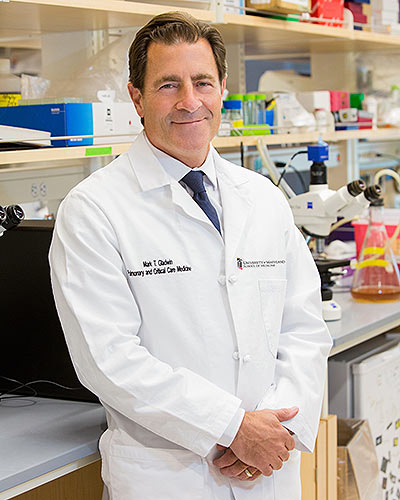
Wednesday, November 29, 2023
University of Maryland School of Medicine Dean Mark T. Gladwin Leads International Randomized Clinical Trials for Novel Sickle Cell Treatment
University of Maryland School of Medicine Dean Mark T. Gladwin, MD will join prominent scientists and government health officials this week at a Symposium in Rio De Janeiro, Brazil, to discuss new treatments for sickle cell disease (SCD). The disease, which afflicts 20 million people around the world, notably affects the Black community, reducing their average lifespan by 22 years.

Friday, August 12, 2022
Off and Running: In First Week, Dean Gladwin is Already Making His Mark
Full Week of Events Signals His Values and Priorities for UMSOM and His Commitment to Taking on Our Greatest Global Health Challenges
